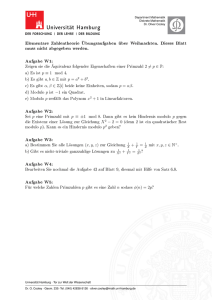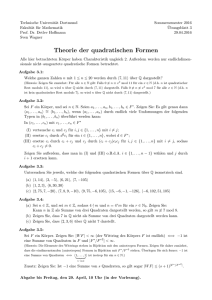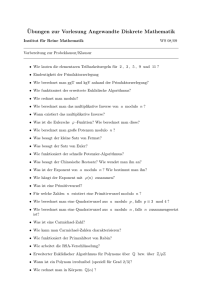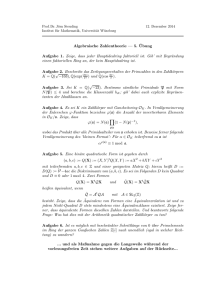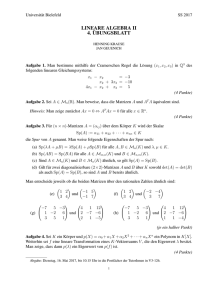Musterlösung 21 - D-MATH
Werbung
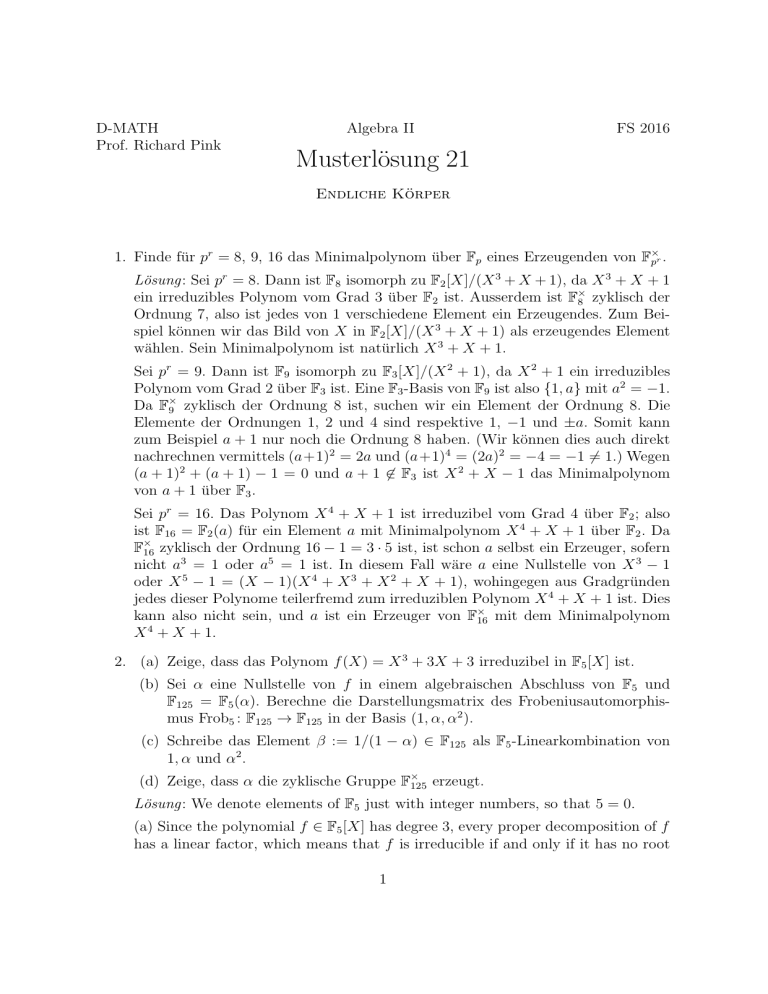
D-MATH
Prof. Richard Pink
Algebra II
FS 2016
Musterlösung 21
Endliche Körper
1. Finde für pr = 8, 9, 16 das Minimalpolynom über Fp eines Erzeugenden von F×
pr .
Lösung: Sei pr = 8. Dann ist F8 isomorph zu F2 [X]/(X 3 + X + 1), da X 3 + X + 1
ein irreduzibles Polynom vom Grad 3 über F2 ist. Ausserdem ist F×
8 zyklisch der
Ordnung 7, also ist jedes von 1 verschiedene Element ein Erzeugendes. Zum Beispiel können wir das Bild von X in F2 [X]/(X 3 + X + 1) als erzeugendes Element
wählen. Sein Minimalpolynom ist natürlich X 3 + X + 1.
Sei pr = 9. Dann ist F9 isomorph zu F3 [X]/(X 2 + 1), da X 2 + 1 ein irreduzibles
Polynom vom Grad 2 über F3 ist. Eine F3 -Basis von F9 ist also {1, a} mit a2 = −1.
Da F×
9 zyklisch der Ordnung 8 ist, suchen wir ein Element der Ordnung 8. Die
Elemente der Ordnungen 1, 2 und 4 sind respektive 1, −1 und ±a. Somit kann
zum Beispiel a + 1 nur noch die Ordnung 8 haben. (Wir können dies auch direkt
nachrechnen vermittels (a+1)2 = 2a und (a+1)4 = (2a)2 = −4 = −1 6= 1.) Wegen
(a + 1)2 + (a + 1) − 1 = 0 und a + 1 6∈ F3 ist X 2 + X − 1 das Minimalpolynom
von a + 1 über F3 .
Sei pr = 16. Das Polynom X 4 + X + 1 ist irreduzibel vom Grad 4 über F2 ; also
ist F16 = F2 (a) für ein Element a mit Minimalpolynom X 4 + X + 1 über F2 . Da
F×
16 zyklisch der Ordnung 16 − 1 = 3 · 5 ist, ist schon a selbst ein Erzeuger, sofern
nicht a3 = 1 oder a5 = 1 ist. In diesem Fall wäre a eine Nullstelle von X 3 − 1
oder X 5 − 1 = (X − 1)(X 4 + X 3 + X 2 + X + 1), wohingegen aus Gradgründen
jedes dieser Polynome teilerfremd zum irreduziblen Polynom X 4 + X + 1 ist. Dies
kann also nicht sein, und a ist ein Erzeuger von F×
16 mit dem Minimalpolynom
X 4 + X + 1.
2. (a) Zeige, dass das Polynom f (X) = X 3 + 3X + 3 irreduzibel in F5 [X] ist.
(b) Sei α eine Nullstelle von f in einem algebraischen Abschluss von F5 und
F125 = F5 (α). Berechne die Darstellungsmatrix des Frobeniusautomorphismus Frob5 : F125 → F125 in der Basis (1, α, α2 ).
(c) Schreibe das Element β := 1/(1 − α) ∈ F125 als F5 -Linearkombination von
1, α und α2 .
(d) Zeige, dass α die zyklische Gruppe F×
125 erzeugt.
Lösung: We denote elements of F5 just with integer numbers, so that 5 = 0.
(a) Since the polynomial f ∈ F5 [X] has degree 3, every proper decomposition of f
has a linear factor, which means that f is irreducible if and only if it has no root
1
in F5 . Since f (0) = 3, f (1) = 2, f (2) = 2, f (3) = 4 and f (4) = 4, we obtain that
f has no root in F5 , therefore it is irreducible in F5 .
(b) Since α is a root of f , we have
α3 = −3α − 3 = 2(α + 1) and
(α + 1)3 = α3 + 3α2 + 3α + 1 = 3(α2 + 1),
which implies in particular that
α9 = −α2 − 1.
To compute the matrix of Frob5 : x 7→ x5 with respect to the basis (1, α, α2 ), where
α is a root of f , we write down the images of 1, α and α2 as F5 -linear combinations
of 1, α and α2 . We get the following:
Frob5 (1) = 1
Frob5 (α) = α5 = α2 · 2 · (α + 1) = 2α3 + 2α2 = −1 − α + 2α2
Frob5 (α2 ) = α · α9 = −α3 − α = −2 + 2α
Then the matrix associated to Frob5 with respect to the basis (1, α, α2 ) is
1 −1 −2
2 .
MFrob5 = 0 −1
0
2
0
(c) Suppose that β = λ+µα+να2 for λ, µ, ν ∈ F5 . Then the condition 1 = β(1−α)
gives
1 = λ + (µ − λ)α + (ν − µ)α2 − να3 = λ + 3ν + (3ν + µ − λ)α + (ν − µ)α2 ,
which is equivalent to
λ + 3ν = 1
3ν + µ − λ = 0
ν − µ = 0.
Solving the equations backwards we obtain µ = ν, λ = 4ν and 7ν = 1, so that the
unique solution is (λ, µ, ν) = (2, 3, 3), and β = 2 + 3α + 3α2 .
(d) The group F×
125 is cyclic of order 124 = 4 · 31, and by Lagrange’s theorem
applied to the subgroup hαi we see that the order of α is a divisor of 124. We want
to prove that indeed ordF×125 (α) = 124, and this can be done by checking that α4
and α62 both differ from 1, since every proper divisor of 124 divides either 4 or 62.
Of course, α4 = 2(α2 + α) 6= 1, so that we are left to check that α62 6= 1. We have
α62 = α−1 (α9 )7 = −α−1 (α2 + 1)7 .
2
To proceed with the computation, notice that
(α2 + 1)3 = α6 + 3α4 + 3α2 + 1 = 4(α + 1)2 + α2 + α + 3α2 + 1 = 3α2 − α,
(α2 + 1)6 = (3α2 − α)2 = −α4 − α3 + α2 = −α2 + α − 2 and
(α2 + 1)7 = (−α2 + α − 2)(α2 + 1) = −α4 − α2 + α3 + α − 2α2 − 2 = α.
Then
α62 = −α−1 α = −1 6= 1,
and we can conclude that α generates F×
125 .
3. Sei K ein Körper der Charakteristik p > 0 und sei a ∈ K.
(a) Zeige, dass das Polynom f (X) := X p − X − a ∈ K[X] separabel ist.
(b) Sei α eine Nullstelle von f in einem algebraisch abgeschlossenen Oberkörper
L von K. Zeige die Mengengleichheit
{β ∈ L : f (β) = 0} = {α + x : x ∈ Fp }.
(c) Zeige, dass im Fall a ∈
/ {y p − y : y ∈ K} die Körpererweiterung K(α)/K den
Grad p hat. Was geschieht im Fall a ∈ {y p − y : y ∈ K}?
(d) Zeige, dass im Fall a ∈
/ {y p − y : y ∈ K} die Gruppe AutK (K(α)) zyklisch
der Ordnung p ist.
(e) Konstruiere auf diese Weise für K = Fp einen Körper der Ordnung pp .
Lösung: (a) We proved in the lecture that f is separable if and only if f and f 0
are coprime. Because f 0 (X) = pX p−1 − 1 = −1 this is indeed the case.
(b) Because f is separable and has degree p, it has exactly p roots in L. Therefore,
both sets have the same finite cardinality, namely p, and to show that they are the
same it suffices to show that one is included in the other. Recall that the Frobenius
of degree p is a field endomorphism of L which is the identity on Fp . Thus for all
x ∈ Fp we have
f (α + x) = (α + x)p − (α + x) − a = αp + xp − α − x − a = f (α) + xp − x = 0.
Hence {β ∈ L : f (β) = 0} ⊃ {α + x : x ∈ Fp } and the equality follows.
(c) We start with the easy case: If a = y p − y for some y ∈ K, then α = y ∈ K is
a root of f (X) = X p − X − (y p − y). By (b), any root of f is in K. This means
that K(α) = K and f decomposes into linear factors over K.
Now assume that a 6∈ {y p − y : y ∈ K}, i.e. ∀y ∈ K : y p − y 6= a. Then all the
roots α + x of f lie outside K, and we claim that f is irreducible. This claim then
3
implies that f ist the minimal polynomial of α over K so that K(α) has degree p
over K.
To prove our claim, consider any monic factor g ∈ K[X] of f . Then by (b) we
have
Y
g(X) =
(X − α − x)
x∈I
in L[X] for some nonempty subset I ⊆ Fp . Set d := |I| = deg(g), which by
construction satisfies 0 < d 6 p. Then the coefficient of X d−1 in g is
X
X
−
(α + x) = −dα −
x.
x∈I
x∈I
P
This coefficient needs to be in K, and since x∈I x ∈ Fp ⊆ K, this implies dα ∈ K.
As α 6∈ K, this is only possible if p|d, which implies d = p. Thus any factor of f
has degree p = deg(f ) and is therefore equal to f . This makes f irreducible.
(d) Nach (c) ist K(α) ein Stammkörper des irreduziblen Polynoms f über K. Nach
§5.7 der Zusammenfassung stehen folglich die Endomorphismen ϕ : K(α) → K(α)
über K in Bijektion zu den Wurzeln von f in K(α). Wegen [K(α)/K] < ∞ ist
ausserdem jeder solche Endomorphismus bereits ein Automorphismus. Die Gruppe
AutK (K(α)) steht also in Bijektion zu Fp und hat deshalb die Ordnung p. Da p
eine Primzahl ist, kann AutK (K(α)) dann nur zyklisch sein.
(Tatsächlich ist die Bijektion zwischen AutK (K(α)) und Fp bereits ein Gruppenisomorphismus. Denn zu jedem x ∈ Fp sei ϕx der eindeutige Endomorphismus mit
ϕx (α) = α + x. Für alle x, y ∈ Fp gilt dann
ϕx (ϕy (α)) = ϕx (α + y) = ϕx (α) + ϕx (y) = (α + x) + y = α + (x + y) = ϕx+y (α).
Die Eindeutigkeit der Bijektion zeigt dann ϕx ◦ ϕy = ϕx+y ; somit ist die Bijektion
ein Homomorphismus und folglich ein Isomorphismus.)
(e) Nach (c) genügt es, das Element a in der Menge Fp r {y p − y : y ∈ Fp } zu
wählen. Diese Menge ist gleich Fp r {0}; also tut es zum Beispiel a = 1. Somit ist
X p −X −1 ∈ Fp [X] irreduzibel, und jeder Stammkörper davon ist eine Erweiterung
von Fp vom Grad p, also ein Körper der Ordnung pp .
**4. Ein Ring, der alle Körperaxiome ausser vielleicht die Kommutativität der Multiplikation erfüllt, heisst eine Divisionsalgebra oder ein Schiefkörper. Der Satz von
Wedderburn besagt, dass jeder endliche Schiefkörper kommutativ ist.
Wähle n > 1. Versuche für n Stunden, selbst einen Beweis dafür zu finden. Vergleiche das Resultat mit bekannten Beweisen, wie zum Beispiel hier:
https://en.wikipedia.org/wiki/Wedderburn%27s little theorem
4
*5. Sei p eine ungerade
Primzahl. Für jede zu p teilerfremde ganze Zahl x ist das
Legendresymbol xp definiert durch:
x
1 falls ∃ a ∈ Z : x ≡ a2 modulo (p),
:=
−1 sonst,
p
was nur von der Restklasse von x modulo (p) abhängt. Das quadratische Reziprozitätsgesetz von Gauss besagt
(p−1)(q−1)
p
q
4
·
= (−1)
q
p
für je zwei verschiedene ungerade Primzahlen p und q. Dies sei im Folgenden
vorausgesetzt.
(a) Zeige
p−1
x
≡ x 2 modulo (p),
p
und dass diese Kongruenz das Legendresymbol eindeutig bestimmt.
(b) Zeige, dass für alle zu p teilerfremden ganzen Zahlen x und y gilt
xy
x
y
=
·
.
p
p
p
(c) Beweise den ersten Ergänzungssatz zum quadratischen Reziprozitätsgesetz:
p−1
−1
= (−1) 2 .
p
(d) Beweise den zweiten Ergänzungssatz zum quadratischen Reziprozitätsgesetz:
p2 −1
2
= (−1) 8 .
p
s(s+1)
p−1
2
und zeige s! ≡ 2s s!(−1) 2 modulo (p), unter
s(s+1) Qs
j
Benutzung von s! = (−1) 2
j=1 (−1) j und −j ≡ p − j modulo (p).]
(e) Finde Kongruenzbedingungen für p, die zu 13
= 1 äquivalent sind.
p
[Hinweis: Setze s :=
(f) Folgere, dass für eine Primzahl p ≡ 6 mod (13) nur endlich viele n ∈ Z>0
existieren, so dass n! + np − n + 13 ein Quadrat in Z ist.
(**g) Zeige, dass für alle p und x der Wert von xp in O(max{log |x|, log p}) Schritten effektiv berechnet werden kann, falls ganze Zahlen y in O(log |y|) Schritten
faktorisiert werden können.
5
Lösung: (a) Betrachte die beiden Homomorphismen
s:
t:
×
F×
a 7→ a2 ,
p → Fp
p−1
×
F×
a→
7 a 2 .
p → Fp
Da p ungerade ist, hat Kern(s) = {±1} die Ordnung 2. Nach Lagrange und dem
und somit den Index 2.
Homomorphiesatz hat Bild(s) folglich die Ordnung p−1
2
p−1
die
Gleichung
t(s(a))
=
a
= 1; also haben wir
Sodann gilt für alle a ∈ F×
p
Bild(s) ⊂ Kern(t). Schliesslich ist t nicht der triviale Homomorphismus, da die
p−1
Gleichung t(a) = a 2 = 1 nur höchstens p−1
< |F×
p | verschiedene Lösungen
2
haben kann. Darum ist Kern(t) eine echte Untergruppe von F×
p . Da sie aber die
Untergruppe Bild(s) vom Index 2 enthält, muss Kern(t) = Bild(s) sein.
×
Nach Konstruktion besteht Bild(s) aus allen Quadraten in F×
p . Also ist a ∈ Fp ein
p−1
p−1
Quadrat genau dann, wenn t(a) = a 2 = 1 ist. Wegen (a 2 )2 = ap−1 = 1 gilt im
p−1
anderen Fall a 2 = −1. Wenn wir dies auf eine zu p teilerfremde ganze Zahl x
übertragen, folgt, dass x kongruent zu einem Quadrat modulo p ist genau dann,
p−1
p−1
(p) ist, und andernfalls ist x 2 ≡ −1 modulo (p). Nach
wenn x 2 ≡ 1 modulo
der Definition von xp ist dies genau die Kongruenz in (a).
[Aliter: Benutze, dass F×
p zyklisch ist, und übertrage die Rechnung auf Z/(p−1)Z.]
Wegen p > 2 ist 1 6≡ −1 modulo (p); folglich ist das Legendresymbol durch diese
Kongruenz schon eindeutig bestimmt. Damit ist (a) gezeigt.
(b) Aus (a) folgt
p−1
p−1
p−1
x
xy
y
≡ (xy) 2 = x 2 · y 2 ≡
·
p
p
p
modulo (p).
Da die äusseren Werte in {±1} liegen, folgt wegen p > 2 schon die Gleichheit.
(c) folgt ebenfalls mit x = −1 direkt aus (a) und p > 2.
(d) Zuerst rechnen wir
s! =
s
Y
j=1
s
s
s
s
Y
Y
Y
Ps
s(s+1) Y
j
j
j
j =
(−1)
(−1) j = (−1) j=1
(−1)j j.
j = (−1) 2
j=1
j=1
j=1
j=1
Dann teilen wir das letzte Produkt auf nach der Parität von j:
s
s
s
s
k=1
k=1
k=1
k=1
d2e
b2c
d2e
b2c
s
Y
Y
Y
Y
Y
j
(2k) (−(2k − 1)) ≡
(2k) (p − 2k + 1) modulo (p).
(−1) j =
j=1
In der letzten Formel durchlaufen die Faktoren beider Produkte alle positiven
geraden Zahlen < p genau einmal. Also gilt
s
s
Y
Y
(−1)j j ≡
(2`) = 2s s! modulo (p).
j=1
`=1
6
Insgesamt folgt damit
s! ≡ (−1)
Wegen 0 < s =
2
s(s+1)
2
2s s! modulo (p).
p−1
2
< p ist aber p - s!; durch Kürzen erhalten wir also
p−1
2
= 2s ≡ (−1)
s(s+1)
2
= (−1)
p2 −1
8
modulo (p).
Mit (a) folgt nun
p2 −1
2
= (−1) 8 .
p
(e) Für jede Primzahl p 6= 13 besagt das quadratische Reziprozitätsgesetz
p
p−1 13−1
13
p
=
· (−1) 2 2 =
.
p
13
13
Wir müssen also nur die Quadrate in F×
13 bestimmen. In F13 haben wir
(±1)2 = 1, (±2)2 = 4, (±3)2 = −4, (±4)2 = 3, (±5)2 = −1, (±6)2 = −3.
= 1 genau dann, wenn p ≡ ±1, ±3 oder ±4 modulo 13 ist.
Also ist 13
p
(f) Schreibe γp (n) := n! + np − n + 13. Für jedes n > p gilt p|n!; ausserdem ist
np ≡ n mod (p) nach dem kleinen Satz von Fermat. Also ist dann γp (n) ≡ 13 mod
(p). Ist nun γp (n) ein Quadrat in Z, so ist folglich 13 kongruent zu einem Quadrat
= −1,
modulo (p). Nach der Voraussetzung p ≡ 6 mod (13) und (e) ist aber 13
p
und wir erhalten einen Widerspruch. Somit ist γp (n) für kein n > p ein Quadrat
in Z. Insbesondere gibt es nur endlich viele (nämlich weniger als p) positive ganze
Zahlen n, für die γp (n) ein Quadrat ist.
(g) Hinweis: Vergleiche die Situation mit der für den euklidischen Algorithmus.
7
